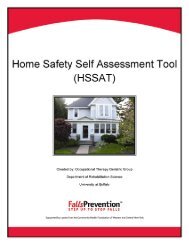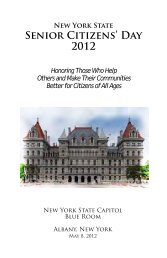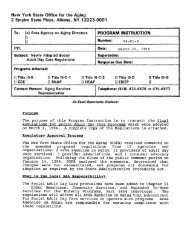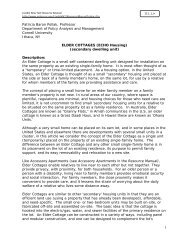Sustaining Informal Caregivers - New York State Office for the Aging
Sustaining Informal Caregivers - New York State Office for the Aging
Sustaining Informal Caregivers - New York State Office for the Aging
Create successful ePaper yourself
Turn your PDF publications into a flip-book with our unique Google optimized e-Paper software.
Caregiving Rewards<br />
Caregiving Rewards and Burdens<br />
Although caregiving can be stressful, it also can provide positive benefits and rewards to<br />
caregivers. In fact, many survey respondents reported positive emotional rewards. <strong>Caregivers</strong><br />
surveyed reported that at least sometimes <strong>the</strong>y feel caregiving gives <strong>the</strong>m a sense of:<br />
• Helping <strong>the</strong> care receiver (99 percent);<br />
• Satisfaction (92 percent);<br />
• Helping family (90 percent);<br />
• Accomplishment (90 percent);<br />
• Being appreciated (87 percent); and<br />
• Have companionship (67 percent).<br />
Caregiving Burdens<br />
There also may be some negative consequences to caregiving, including financial, emotional,<br />
and physical strain <strong>for</strong> caregivers. <strong>Caregivers</strong> indicated that <strong>the</strong>y at least sometimes feel <strong>the</strong><br />
following burdens:<br />
• Emotional strain (90 percent);<br />
• Not having enough time <strong>for</strong> self (86 percent);<br />
• Causing physical stress (77 percent);<br />
• Conflicts with social life (74 percent);<br />
• Affecting health (74 percent);<br />
• Not having enough time <strong>for</strong> family (72 percent);<br />
• Interference with work (59 percent); and<br />
• Financial burden (53 percent).<br />
Service Satisfaction and Outcomes<br />
Caregiver Support Services Utilization and Satisfaction<br />
When asked about where caregivers first heard about family caregiver support programs in <strong>the</strong><br />
aging services network, <strong>the</strong> top three sources of in<strong>for</strong>mation were:<br />
• From family or friends (22 percent);<br />
• The state (NYSOFA) or local office <strong>for</strong> <strong>the</strong> aging (AAA) (19 percent); and<br />
• A case manager or a social worker (14 percent).<br />
O<strong>the</strong>r sources of in<strong>for</strong>mation include: a community organization (e.g., senior center, Alzheimer’s<br />
Association, caregiver support group, Veterans Hospital, United Way Hotline, Senior<br />
<strong>New</strong>sletters, and website), a physician or hospitals, TV/radio/newspaper, and o<strong>the</strong>r media.<br />
12








